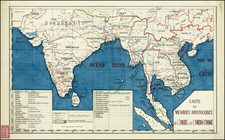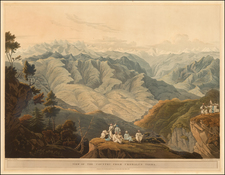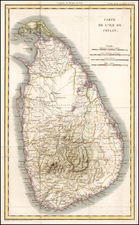Map illustrating the route of Johann Albrecht von Mandeslos from Persia to India during the years 1637-1640.
Highly detailed route map, focused on the overland route from Goa to Visapour and Visapour to Dabul.This map was most likely based on Johann Albrecht von Mandeslos Journal on his voyages in Persia and India during the years 1637-1640.
Johann Albrecht de Mandeslo (1616-1644) was a seventeenth-century German adventurer, who wrote about his travels through Persia and India. After traveling to Isfahan with a diplomatic mission, he separated from the party and made his way to India, where he made interesting observations on the Mughal Empire, then ruled by Shah Jahan. In 1638, Mandeslo visited the ruins at Persepolis in Persia. Arriving at the port of Surat in April, 1638, he moved on to Ahmedabad and Agra. While his observations of life in the capital are useful, he apparently heard nothing about the Taj Mahal, then in its sixth year of construction. He then traveled to Lahore before continuing his journey through the empire's southern provinces and travelling on to the Far East. Mandeslo is an apparent engaging and cheerful writer, whose enthusiasm for indiscriminately shooting wildlife did not endear him to his Indian travelling companions.
When Mandeslo was traveling through India, it was during the reign of Shah Jahan the Mughal, the emperor who is most famous for building the Taj Mahal. During his reign Shah Jahan signals an abrupt return to a stricter interpretation of Islam when he orders that all recently built Hindu temples shall be destroyed, and it becomes standard policy during the reign of his son Aurangzeb. His determination to impose strict Islamic rule on India undoes much of what was achieved by Akbar. At the same time Aurangzeb is obsessed with extending Moghul rule into the difficult terrain of southern India. He leaves the empire larger but weaker than he finds it. In his eighties he is still engaged in permanent and futile warfare to hold what he has seized. The Real power has declined gradually and imperceptibly throughout the 17th century, ever since the expansive days of Akbar's empire. Yet it is in the 17th century that news of the wealth, splendour, architectural brilliance and dynastic violence of the Moghul dynasty first impresses the rest of the world. Europeans become a significant presence in India for the first time during the 17th century, such as Mandeslo. They take home descriptions of the ruler's fabulous wealth, causing him to become known as the Great Moghul. They have a touching tale to tell of Shah Jahan's love for his wife and of the extraordinary building, the Taj Mahal, which he provides for her tomb. Many European nations follow the Portuguese in gaining footholds in India. Portugal held the colony of Goa, which was the center of Christianization in the East.
Pierre Duval (1618-1683) was a French geographer, cartographer, and publisher who worked in Abbeville and Paris during the seventeenth century. He was born in the former city, in northeast France, before moving to Paris. Duval was the nephew of the famous cartographer Nicolas Sanson, from whom he learned the mapmaker's art and skills. Both men worked at the royal court, having followed the royal request for artists to relocate to Paris. In addition to numerous maps and atlases, Du Val's opus also includes geography texts. He held the title of geographe ordinaire du roi from 1650 and died in 1683, when his wife and daughters took over his business.









![[India] Tabula Asiae X](https://storage.googleapis.com/raremaps/img/small/89683.jpg)
![[ Kashmir ] Vacances au Cachemire](https://storage.googleapis.com/raremaps/img/small/80937.jpg)



![[ Tibet / Nepal / Himalyas ] Carte von Tibet nach den neuesten Nachrichten entworfen 1790](https://storage.googleapis.com/raremaps/img/small/86165.jpg)